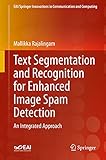Text Segmentation and Recognition for Enhanced Image Spam Detection [electronic resource] : An Integrated Approach / by Mallikka Rajalingam.
By: Rajalingam, Mallikka [author.] .
.
Contributor(s): SpringerLink (Online service) .
.
Material type:  BookSeries: EAI/Springer Innovations in Communication and Computing: Publisher: Cham : Springer International Publishing : Imprint: Springer, 2021Edition: 1st ed. 2021.Description: IX, 114 p. 31 illus., 23 illus. in color. online resource.Content type: text Media type: computer Carrier type: online resourceISBN: 9783030530471.Subject(s): Telecommunication
BookSeries: EAI/Springer Innovations in Communication and Computing: Publisher: Cham : Springer International Publishing : Imprint: Springer, 2021Edition: 1st ed. 2021.Description: IX, 114 p. 31 illus., 23 illus. in color. online resource.Content type: text Media type: computer Carrier type: online resourceISBN: 9783030530471.Subject(s): TelecommunicationChapter 1. Introduction -- Chapter 2. Review of Literature -- Chapter 3. Methodology -- Chapter 4. Character Segmentation -- Chapter 5. Character Recognition -- Chapter 6. Classification/Feature Extraction Using SVM and KNN Classifier -- Chapter 7. Experimentation and Result discussion -- Chapter 8. Conclusion. .
This book discusses email spam detection and its challenges such as text classification and categorization. The book proposes an efficient spam detection technique that is a combination of Character Segmentation and Recognition and Classification (CSRC). The author describes how this can detect whether an email (text and image based) is a spam mail or not. The book presents four solutions: first, to extract the text character from the image by segmentation process which includes a combination of Discrete Wavelet Transform (DWT) and skew detection. Second, text characters are via text recognition and visual feature extraction approach which relies on contour analysis with improved Local Binary Pattern (LBP). Third, extracted text features are classified using improvised K-Nearest Neighbor search (KNN) and Support Vector Machine (SVM). Fourth, the performance of the proposed method is validated by the measure of metric named as sensitivity, specificity, precision, recall, F-measure, accuracy, error rate and correct rate. Presents solutions to email spam detection and discusses its challenges such as text classification and categorization; Analyzes the proposed techniques’ performance using precision, F-measure, recall and accuracy; Evaluates the limitations of the proposed research thereby recommending future research.


There are no comments for this item.